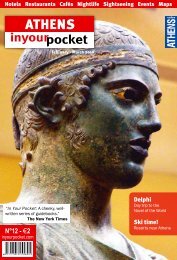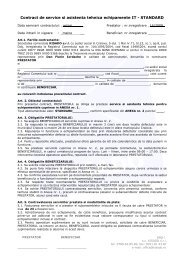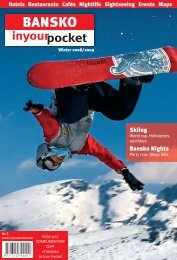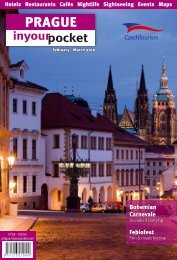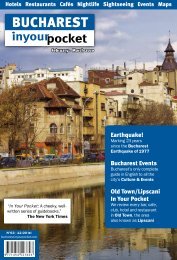DUBROVNIK - KISADO
DUBROVNIK - KISADO
DUBROVNIK - KISADO
You also want an ePaper? Increase the reach of your titles
YUMPU automatically turns print PDFs into web optimized ePapers that Google loves.
48 dubrovnik neretva county<br />
dubrovnik neretva county<br />
49<br />
Lastovo is a town of<br />
chimneys. In times past,<br />
a sign of the wealth of<br />
a household was the<br />
size and ornateness<br />
of on e’s chimn ey,<br />
an d many unusual<br />
examples still stand.<br />
Another vital aspect<br />
of Lastovo’s heritage<br />
is the “Poklad” - the<br />
traditional pre-Lent<br />
carnival celebrating the<br />
island’s deliverance<br />
from Catalan pirates.<br />
A n e ff i g y o f t h e<br />
Catalan messenger<br />
takes centre stage,<br />
spectacularly released<br />
from a hilltop to slide<br />
on a rope to the town<br />
centre with firecrackers exploding at its feet. Humiliating<br />
indeed. At this time, as well as during summertime festivals,<br />
you can see the island’s folk costume, where the men wear<br />
scarlet and black with embroidered braces and hats decked<br />
with colourful flowers.<br />
With so little (except carnivals) to disturb them, fish adore<br />
Lastovo, and you can be sure of an excellent meal here.<br />
Lastovo has poor transport connections, few shops, and<br />
there is little accommodation with a few families offering<br />
private rooms. But if you’re ready and able to explore, and<br />
happy to adapt to the treacle-slow passage of time here, this<br />
could well be the start of an enduring love affair.<br />
Mljet<br />
Sounds of Mljet<br />
A breeze brushing through pine boughs ... the flapping of a<br />
sail out in the channel, heard from high on a seaside ridge ...<br />
the bray of a donkey. Silence.<br />
Mljet gets a growing share of tourists, but as one of the more<br />
remote and less developed islands, with limited ferry service,<br />
it lacks the kind of mass tourism of much of the Dalmatian<br />
coast and some other more accessible islands. This isn’t<br />
the place to come for late night bars, concerts, discos. One<br />
might hope it never will be. A ferry connects the island with<br />
the Pelješac Peninsula.<br />
Be prepared to fall in love with nature all over again, for this<br />
island has a stunning quality waiting for you to discover.<br />
Croatia’s 8th largest island is approximately 3 km wide and 37<br />
km long making it attractive to explore for a short or lengthier<br />
stop. It has an area of roughly 100 square km with 131 km<br />
of coastline and many little niches and coves to discover, so<br />
you’d be forgiven for wanting to stay. With five distinct forest<br />
tree varieties, abundant fauna and lush vegetation, it’s easy<br />
to see why Mljet is called the “Green Island.” Mljet offers<br />
a panorama of coastline, cliffs, reefs and numerous islets<br />
as well as the rich topography of the hills that rise steeply<br />
above the sea and plummet back into deep valleys sheltering<br />
ancient stone villages. The submarine world includes quite<br />
an array of fish and several types of corals. With fantastic<br />
weather, recreational sports, hiking and bicycle paths are<br />
only a fraction of the pleasures that you can enjoy here. The<br />
western end of Mljet has been protected as a National Park<br />
since 1960.<br />
The ancient Greeks who settled here left the first record of<br />
the place, calling it Melissa or Melitta, (meaning, bee; honey)<br />
because of the many bees that made their home there. Greek<br />
settlers became familiar with this island whilst colonising<br />
nearby Vis (Issa), Hvar (Pharos) and Korčula (Korkiru).<br />
The Illyrians settled the entire island in the 2nd Century<br />
BC, leaving graves and traces of military fortifications and<br />
settlements in seven places, on hills near water sources. The<br />
best preserved sites are located on Veliki Gradac hill above<br />
the Veliko Jezero, and the fort of Vodica near Babino Polje.<br />
The Romans followed, their era lasting from the 2nd Century<br />
BC to the 7th century AD. After Octavian wiped out the Illyrians<br />
in 35 BC, the Romans built their own settlements on the<br />
western side of the island. Evidence of their domain is most<br />
notable in Polače, where they built a palace. Other Roman<br />
ruins are located in Pomena, Žara and Pinjevci.<br />
The Croatian-Slavic nobility settled along the entire Adriatic<br />
coast around the end of the 8th and the start of the 9th<br />
Century. During this period of weakened Byzantine influence in<br />
the region, Croatians descended from the Neretva Valley and<br />
some settled on Mljet. The Romans, however, remained on<br />
the western end of the mountain for about another 300 years,<br />
until they were defeated in a battle on the mountain Bijeđ,<br />
between Blato and Polače. Evidence of this battle, including<br />
mass graves and remnants of bones, spears, swords and<br />
arrows, was discovered in 1938.<br />
In 1151, Prince Desa of Zahumlje donated the entire island<br />
of Mljet to the Benedictine Abbey of St Mary of Pulsano from<br />
Apulia. Their arrival saw the construction of a church and<br />
grand monastery (1177-1198) on the islet in Veliko Jezero.<br />
Ragusa (later called Dubrovnik), acquired the Pelješac<br />
Peninsula in 1333, leaving Mljet isolated for a time. This<br />
changed in 1410, however, when Ragusa, now independent<br />
of Venice, annexed Mljet. Ragusa held the island until the<br />
dissolution of the Republic under Napoleon in 1808.<br />
Tourist information<br />
Tourist Board Mljet tel. 74 60 25, fax 74 60 25,<br />
tz-mljet@du.t-com.hr, www.mljet.hr. Sobra office<br />
(around the side of the café at the ferry pier).<br />
Tourist Board Goveđari (office actually in Polače),<br />
tel. 74 41 86, fax 74 41 86. January - June 08:00 -<br />
13:00. Closed Sat, Sun.<br />
Getting There and Around<br />
Transportation to the island is provided by Jadrolinija ferry<br />
from Pelješac. Mljet is only 8km away from the peninsula of<br />
Pelješac, 18km from Korčula and 30km from Dubrovnik. There<br />
are a number of harbour ports in Mljet. Polače is its largest and<br />
main port of call in the north. Other harbours include Okuklje,<br />
Luka Prožura, Sobra, Kozarica and Pomena which has daily<br />
connections to Dubrovnik (watch out for reefs and shallow<br />
water), and Lokve or Gonoturska port where you can throw<br />
anchor just before the entry canal toward the Big Lake.<br />
What to See<br />
National Park Mljet (Nacionalni Park Mljet)<br />
Pristanište 2, Goveđari, tel. 74 40 41, 74 40 58, npmljet@np-mljet.hr,<br />
turizam@np-mljet.hr, www.np-mljet.<br />
hr. Established in 1960, the park is Mljet’s top attraction. The<br />
park encompasses 54 square kilometres at the western end<br />
of the island, with an astonishing interior and coastline beauty.<br />
Veliko Jezero and Malo Jezero (Big Lake and Small Lake),<br />
and the villages of Soline, Babine Kuće, Pomena, Polače and<br />
Goveđari all lie within park boundaries. Of interest, this park<br />
represents the first institutionalised attempt to protect the<br />
native eco-system in the Adriatic.<br />
The lakes, 145-hectare Veliko Jezero and 24-hectare Malo<br />
Jezero, are the park’s dominant features. Thirty-meter-long<br />
channels link the two lakes and provide an outlet from Veliko<br />
Jezero to the sea. The current in the channels, swift enough to<br />
power mills during the Middle Ages, switches direction every<br />
six hours. On foot or by pedal you can enjoy a 9-kilometer<br />
path which circumnavigates the lakes, and other paths wind<br />
up and over the hills. It’s OK to swim or paddle in the lake, but<br />
scuba diving and motor boats are not permitted.<br />
The usual national park rules apply: Don’t pick the flowers,<br />
steal the artifacts, fish without a special permit, nor litter, and<br />
most of all, don’t start fires. Mjet is one of the most verdant of<br />
Croatia’s islands because it wasn’t heavily logged or used for<br />
farming or herding. Nevertheless, a 1917 fire took out many<br />
of the deciduous forests.<br />
www.inyourpocket.com<br />
Tickets to the park cost 40 - 90 kn and during the winter you<br />
should call prior coming for the ferry to St Mary Island to be<br />
organised in the middle of Veliko Jezero, where you will find<br />
the Benedictine monastery.<br />
Benedictine Monastery on the islet of St Mary<br />
(Samostan Sv Marija) This tiny island, in a lake on the island of<br />
Mljet, is at the island’s cultural and spiritual heart. For a time,<br />
the monastery was the island’s governmental center.<br />
Benedictines, members of a monastic order who live in<br />
autonomous communities dedicated to work, prayer and<br />
peace, came to Mljet from Monte Gargano, Italy in the 12th<br />
Century to establish a monastery and build a Romanesque<br />
church dedicated to St Mary, which they completed in 1198.<br />
In the process the Benedictines became the island’s feudal<br />
lords, but they are credited with developing literacy, culture<br />
and art. The Church of St Mary was repeatedly modified over<br />
the centuries, acquiring by the 13th Century decorative reliefs<br />
of saints and a typical Romanesque belltower. Renaissance<br />
features such as the Gundulić coat of arms over the church<br />
portal, defensive towers and walls, the two-storey structure<br />
of the monastery and Baroque side chapels were added<br />
during the 16th and 17th centuries. In 1809, during the rule<br />
of Napoleon, the monastery was abandoned and the Austrian<br />
Forestry Office for Mljet used the buildings for offices until<br />
1941. In 1960 it was renovated into a lovely hotel but given<br />
back to the bishopric in 1997, just under 800 years from the<br />
church’s inauguration.<br />
The church has been reconsecrated, but other than a<br />
restaurant in the monastery cellars (during summer), the<br />
buildings are unoccupied. The island is small but offers a<br />
pleasant walk past two chapels. You can close your eyes for<br />
a moment and imagine the monks carefully pruning, weeding,<br />
and feeding in the gardens, which are now fairly overgrown.<br />
Polače The village is named for the ruin of a significant<br />
Roman palace and fortifications – one tower is 20m high --<br />
built between the 2nd and the 5th centuries. Second in size<br />
to the Palace of Diocletian in Split, you can’t miss it: the road<br />
to Pomena slips right between its high walls. Archaeologists<br />
have also discovered two 5th Century basilicas west of<br />
the palace, baths, an arsenal and shipyards. The palace’s<br />
economy included salt production, olive oil, wine, honey,<br />
meat, cheese and fish. A paved route from the palace will<br />
take you up the hill. When you reach the road, bear right<br />
and continue straight to Mali Gradac, site of an Illyrian fort.<br />
A posted turnoff on the way will take you to Montokuc, the<br />
highest peak in the park, which grants breathtaking views<br />
over the lakes and the Adriatic.<br />
Dubrovnik In Your Pocket<br />
dubrovnik.inyourpocket.com<br />
dubrovnik.inyourpocket.com<br />
Winter 2009 - Spring 2010



